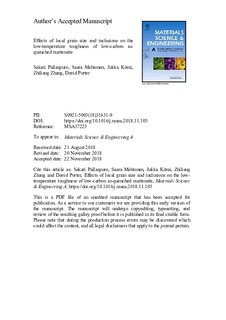| dc.contributor.author | Pallaspuro, Sakari | |
| dc.contributor.author | Mehtonen, Saara | |
| dc.contributor.author | Kömi, Jukka | |
| dc.contributor.author | Zhang, Zhiliang | |
| dc.contributor.author | Porter, David | |
| dc.date.accessioned | 2018-12-17T14:51:06Z | |
| dc.date.available | 2018-12-17T14:51:06Z | |
| dc.date.created | 2018-11-27T16:36:59Z | |
| dc.date.issued | 2018 | |
| dc.identifier.issn | 0921-5093 | |
| dc.identifier.uri | http://hdl.handle.net/11250/2577980 | |
| dc.description.abstract | The segregation of alloying elements that occurs during the solidification of steel leads to microscale and macroscale microstructural heterogeneity that can cause anomalous mechanical behaviour. The centreline macrosegregation of a cast and its increased inclusion content are usually considered to be particularly detrimental in the case of conventional structural steels. Samples from centreline and off-centreline positions in a single continuously cast slab of an ultrahigh-strength steel were subjected to hot rolling, reheating and water quenching to 12 mm thick fully martensitic plates to explore the differences in mechanical properties between a homogeneous clean matrix and a heterogeneous inclusion-rich centreline. Despite the presence of strong macrosegregation and a high inclusion content, the centreline material has a significantly better, i.e. a 15 °C lower, fracture toughness reference temperature T0. However, neither the 28 J Charpy V impact toughness transition temperature T28J nor the tensile properties show notable differences. The inclusion rich heterogeneous material achieves its unexpected toughness properties despite the higher hardness of the centreline and an abundance of large inclusions. Thorough microstructural characterisation shows that the centreline enrichment of alloying elements and impurities leads to a profound refinement in the local grain size, which more than compensates for the expected detrimental effects of the inclusions and the harder microstructure. The results have practical importance regarding the levels of macrosegregation and inclusion contents that can be tolerated by ultrahigh-strength steels. | nb_NO |
| dc.language.iso | eng | nb_NO |
| dc.publisher | Elsevier | nb_NO |
| dc.rights | Attribution-NonCommercial-NoDerivatives 4.0 Internasjonal | * |
| dc.rights.uri | http://creativecommons.org/licenses/by-nc-nd/4.0/deed.no | * |
| dc.title | Effects of local grain size and inclusions on the low-temperature toughness of low-carbon as-quenched martensite | nb_NO |
| dc.title.alternative | Effects of local grain size and inclusions on the low-temperature toughness of low-carbon as-quenched martensite | nb_NO |
| dc.type | Journal article | nb_NO |
| dc.type | Peer reviewed | nb_NO |
| dc.description.version | acceptedVersion | nb_NO |
| dc.source.pagenumber | 611-622 | nb_NO |
| dc.source.volume | 743 | nb_NO |
| dc.source.journal | Materials Science & Engineering: A | nb_NO |
| dc.identifier.doi | 10.1016/j.msea.2018.11.105 | |
| dc.identifier.cristin | 1635953 | |
| dc.description.localcode | © 2018. This is the authors’ accepted and refereed manuscript to the article. Locked until 23.11.2020 due to copyright restrictions. This manuscript version is made available under the CC-BY-NC-ND 4.0 license http://creativecommons.org/licenses/by-nc-nd/4.0/ | nb_NO |
| cristin.unitcode | 194,64,45,0 | |
| cristin.unitname | Institutt for konstruksjonsteknikk | |
| cristin.ispublished | false | |
| cristin.fulltext | postprint | |
| cristin.qualitycode | 2 | |

